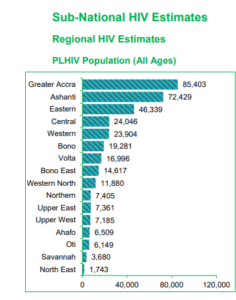HIV Infections In Ghana: Here Are The Regions From Highest To Lowest
The Ghana Aids Commission’s data for 2022 shows that there are a total number of 354,927 persons in the country who are HIV positive, a 2.7% increase from the previous years.
This is reflected in the regional distributions, with the capital having the most cases.
Director General of the Commission, Dr Kyeremeh Atuahene, says most of the HIV carriers are unaware of their status and are spreading the virus to other negative individuals.
Patricia Anum-Dorhuso, Communications Officer of the Commission also explained to The Ghana Report that most of the People living with HIV who know their status are on treatment.
“72 percent of persons living with HIV know their status and 87 percent of those who know their status are on Antiretroviral treatment “, she added.
Under the national HIV data statistics of persons living with the virus, adults aged fifteen years and above are 330,215, children between the age of zero to fourteen years are 24,712, adolescents between ten to nineteen years are 21,439 and young people between the age of fifteen to twenty-four are 40,497.
Analysis of persons living with HIV in the sub-national shows that there are 120,000 persons with the virus in all the 16 regions in Ghana.
The data indicate that Greater Accra Region has the highest number of HIV carriers, with a total number of 85,403 persons; Ashanti Region follows with a total number of 72,429 positive cases.
The next region is Eastern Region with 46,339 positive cases, Central Region has 24,046 positive cases, Western Region has 23,904 positive cases, Bono Region has 19,281 positive cases, Volta Region has 16,996 positive cases, Bono East has 14,617, Western North has 11,880, Northern Region has 7,405, Upper East Region has 7,361 HIV carriers, Upper West has 7,185 positive cases, Ahafo Region has 6,509 positive cases, Oti Region has 6,149 positive cases, Savannah Region has 3,680 positive cases, and the lowest region with the least HIV positive cases is the North East Region with a total number of 1,743 carriers.

The Ghana Aids Commission analysis for the past eight years shows that sexual activities remain the major mode of HIV transmission in Ghana.
The data also revealed that HIV is consistently higher among women than men in all age groups.
Find The 2022 HIV Estimates Fact Sheet Below
[gview file=”https://www.theghanareport.com/wp-content/uploads/2023/08/2022_HIV_Estimates_Fact_Sheetfinal.pdf”]
READ ALSO:



